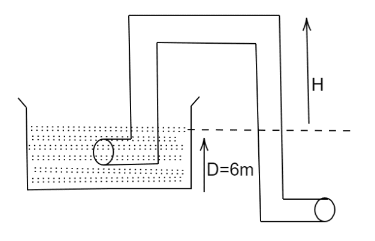
Figure shows a siphon, the vessel area is very large as compared to the cross-section of the tube. Tube has a uniform cross section, its lower end is $ 6m $ below the surface of water. What is the maximum height $ H $ (in $ m $ ) of the upper end for siphon to work? Take density of water $ = {10^3}\dfrac{{kg}}{{{m^3}}} $ , atmospheric pressure $ = {10^5}\dfrac{N}{{{m^2}}} $ .


Answer
471.3k+ views
Hint: Use Bernoulli’s theorem which gives the relation between density, pressure, and height of the fluid above the object. In the above situation, atmospheric pressure will be equal to the pressure exerted by a liquid, using this and putting values in Bernoulli’s equation we will find the required maximum height.
$ P = \rho gh $
Where $ P $ is the pressure, $ \rho $ is the density of water, $ g $ is the gravitational force, and $ h $ is the height of fluid above the object.
Complete step by step answer:
When a fluid is contained within a container, the depth of an object submerged in the fluid can be determined. The greater pressure an object experiences the deeper it is submerged in the fluid. Because of the weight of the fluid above it, this is the case. Due to the weight of the fluid, the more pressure is put on the submerged object the denser the fluid above it is.
Given the density of water $ = {10^3}\dfrac{{kg}}{{{m^3}}} $
$ {P_{atm}} = {10^5}\dfrac{N}{{{m^2}}} $
According to the question, at the highest point of siphon let it be $ P $ the atmospheric pressure will be equal to pressure due to liquid being up to height in siphon. Total height is $ H + 6 $
Therefore, $ {P_{atm}} = \rho g(H + 6) $
$ \Rightarrow {10^5} = {10^3} \times 10(H + 6) $
$ \Rightarrow 10 = H + 6 $
$ \Rightarrow H = 4m $
Hence, the maximum height $ H $ (in $ m $ ) of the upper end for the siphon to work is $ 4m $ .
Note:
The pressure at a specific place in a pipe is affected by the changes in fluid elevation that occur as fluid travels through a piping system where pipes rise and fall, changing height. As a result, as the fluid rises, the pressure in the pipe decreases and as the fluid level drops, the pressure in the pipe rises.
$ P = \rho gh $
Where $ P $ is the pressure, $ \rho $ is the density of water, $ g $ is the gravitational force, and $ h $ is the height of fluid above the object.
Complete step by step answer:
When a fluid is contained within a container, the depth of an object submerged in the fluid can be determined. The greater pressure an object experiences the deeper it is submerged in the fluid. Because of the weight of the fluid above it, this is the case. Due to the weight of the fluid, the more pressure is put on the submerged object the denser the fluid above it is.
Given the density of water $ = {10^3}\dfrac{{kg}}{{{m^3}}} $
$ {P_{atm}} = {10^5}\dfrac{N}{{{m^2}}} $
According to the question, at the highest point of siphon let it be $ P $ the atmospheric pressure will be equal to pressure due to liquid being up to height in siphon. Total height is $ H + 6 $
Therefore, $ {P_{atm}} = \rho g(H + 6) $
$ \Rightarrow {10^5} = {10^3} \times 10(H + 6) $
$ \Rightarrow 10 = H + 6 $
$ \Rightarrow H = 4m $
Hence, the maximum height $ H $ (in $ m $ ) of the upper end for the siphon to work is $ 4m $ .
Note:
The pressure at a specific place in a pipe is affected by the changes in fluid elevation that occur as fluid travels through a piping system where pipes rise and fall, changing height. As a result, as the fluid rises, the pressure in the pipe decreases and as the fluid level drops, the pressure in the pipe rises.
Recently Updated Pages
The number of solutions in x in 02pi for which sqrt class 12 maths CBSE

Write any two methods of preparation of phenol Give class 12 chemistry CBSE

Differentiate between action potential and resting class 12 biology CBSE

Two plane mirrors arranged at right angles to each class 12 physics CBSE

Which of the following molecules is are chiral A I class 12 chemistry CBSE

Name different types of neurons and give one function class 12 biology CBSE

Trending doubts
One Metric ton is equal to kg A 10000 B 1000 C 100 class 11 physics CBSE

What is 1s 2s 2p 3s 3p class 11 chemistry CBSE

Discuss the various forms of bacteria class 11 biology CBSE

State the laws of reflection of light

Explain zero factorial class 11 maths CBSE

An example of chemosynthetic bacteria is A E coli B class 11 biology CBSE




